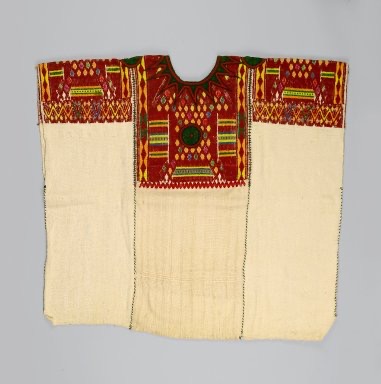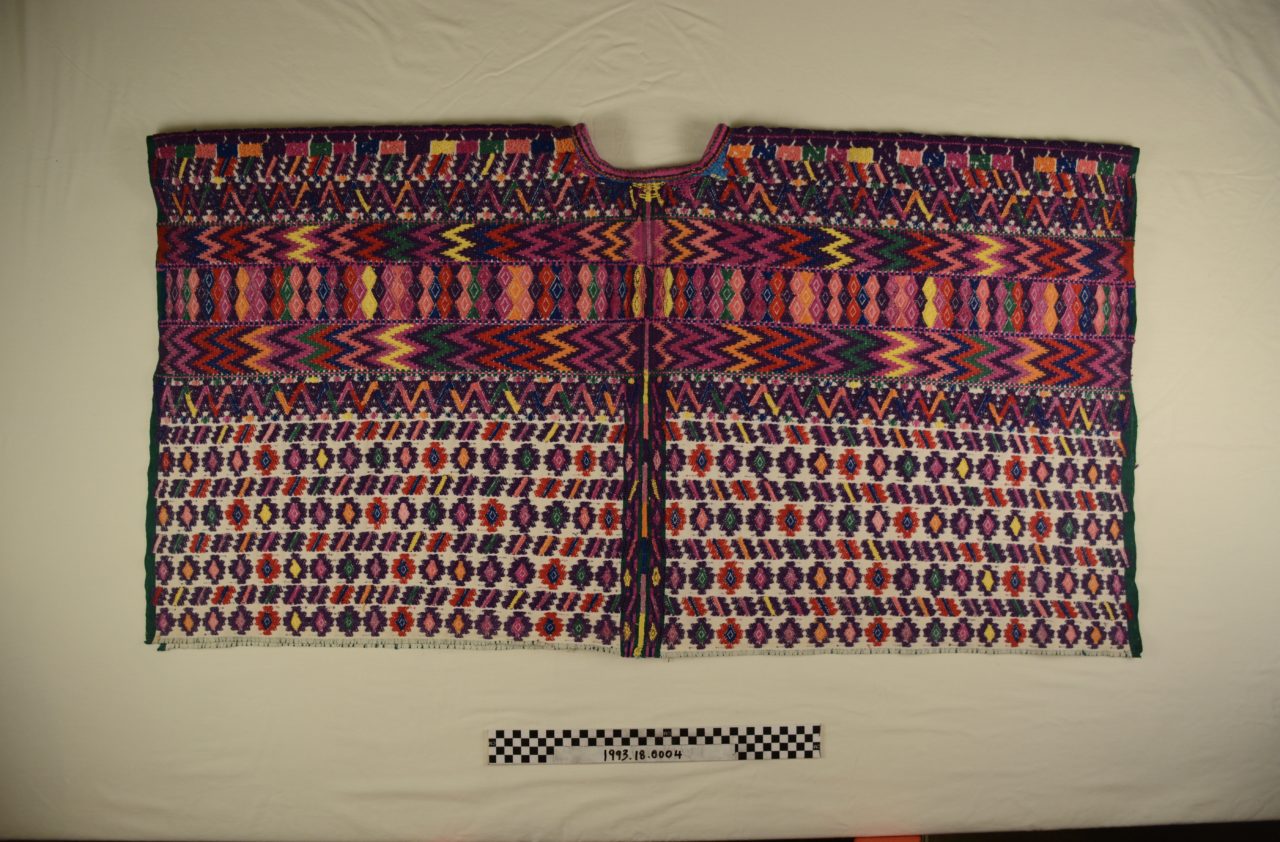A huipil is a woven rectangular shirt worn by women in Central America beginning in ancient times.
The Details
“The huipilli was the basic garment of the upper body, worn by all classes. It was constructed out of a rectangle of cloth with a hole cut at the center for the neckline. The sides were sewn shut with openings at the top for armholes.” (480)
Condra goes on to further explain:
“Decoration was an important part of the garments, and women who were skilled at weaving complex cloth and embroidery also gained social prestige. Design motifs for all classes were both rectilinear and naturalistic forms. Many animal designs appeared, such as forms representing eagles, butterflies, jaguars, and snakes. Some of the geometric patterns were named and potentially held symbolic meanings.” (480)
A 1930s huipil (Fig. 1) in the Brooklyn Museum collection features a multicolored design on the central panel representing a double-headed eagle with the horizontal bars representing its wing and tail feathers. The neck opening with its silk appliqué of radiating points represents the sun, and the four rosettes represent the four directions.
Claire Odland in The Berg Encyclopedia of World Dress and Fashion: Latin America and the Caribbean (2005) describes the origin of the term and its early use:
“The word huipil comes from the Nahuatl language of Mexico, from the word huipilli, but is now commonly used throughout Mesoamerica. Similar tunics or blouses sewn of uncut, rectangular pieces of cloth are found on ancient Maya and Aztec archaeological artifacts including pots, carvings, and figurines; and images were reproduced in the Codices of the Spanish Conquest.” (197)
Similar to that in figure 1, the Guatemalan huipil in figure 2 also features a colorful pattern with different zigzags and dots.
Josephine M. Moreno in The Berg Encyclopedia of World Dress and Fashion: The United States and Canada (2010) discusses the huipil’s more contemporary significance and use:
“In particular the Maya huipil, a square-shaped woman’s top worn by indigenous women in southern Mexico and Guatemala, is increasingly appropriated. The huipil continues to be a significant ethnic marker in Latin America in the early twenty-first century. Huipiles are constructed of hand- or machine-loomed yardage and can be heavily embellished with embroidery, lace, or hand-stitching on the neck and armhole edges. Historically, huipiles indicated the geographic origins of the wearer. However, contemporary native women commonly wear huipiles from villages other than their own. The sale of huipiles, particularly during periods of civil strife, has been common, especially in Guatemala during the last quarter of the twentieth century. Consequently, the garment has been sold to tourists and made available in the global marketplace.” (566)
As seen in figure 3, huipils were traditionally created with a warmer color palette in mind so in many examples of this traditional garment there will be a mix of reds, yellows and purples.
The 1950s-60s huipil featured in figure 4 is a traditional example of this beautiful garment hand-woven from cotton.
Fig. 1 - Designer unknown (Mayan). Woman’s Blouse or Huipil, 1930s or 1940s. Cotton silk; 76.2 cm x 78.7 cm (30 in x 31 in). Brooklyn: Brooklyn Museum, 2005.15.1. Gift in memory of Elizabeth Ege Freudenheim. Source: Brooklyn Museum
Fig. 2 - Designer unknown (Guatemala). Women’s Traditional Blouse (Huipil), 19th Century. Cotton plain weave with silk brocading wefts (finger brocading); 106.7 cm x 67.3 cm (25 1/2 in x 41 in). Philadelphia: Philadelphia Museum of Art, 1967-30-363. The Samuel S. White 3rd and Vera White Collection, 1967. Source: Philadelphia Museum of Art
Fig. 3 - Designer unknown (Guatemala). Ceremonial Huipil, 1930s-1940s. Cotton and silk; 64.77 cm x 104.14 cm (25 1/2 in x 41 in). Dallas: Dallas Museum of Art, 1982.215. Dallas Museum of Art, The Carolyn C. and Dan C. Williams Collection of Guatemalan Textiles. Source: Dallas Museum of Art
Fig. 4 - Designer unknown. Huipil, Po’t, Blouse, 1950-1969. Cotton fiber; 125.9 cm x 61.5 cm x 0.3 cm (49.5 in x 24 in x 0.1 in). Urbana, IL: Spurlock Museum of World Cultures at Illinois, 1993.18.0004. Transfer from Illinois State University. Source: Spurlock Museum of World Cultures at Illinois
References:
- Condra, Jill. “Huipilli.” In The Encyclopedia of National Dress: Traditional Clothing Around the World, edited by Jill Condra, 480. ABC-CLIO, 2013. http://www.worldcat.org/oclc/879022458
- Moreno, Josephine M. “Hispanic and Latino American.” In Berg Encyclopedia of World Dress and Fashion: The United States and Canada, edited by Phyllis G. Tortora, 558–566. Oxford: Bloomsbury Academic, 2010. http://www.worldcat.org/oclc/699693226
- Odland, J. Claire. “The Huipil of Guatemala.” In Berg Encyclopedia of World Dress and Fashion: Latin America and the Caribbean, edited by Margot Blum Schevill, 197–201. Oxford: Bloomsbury Academic, 2005. http://www.worldcat.org/oclc/966963198














